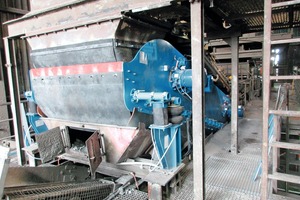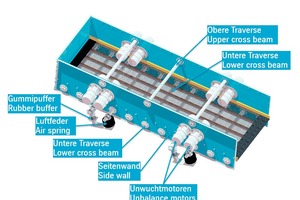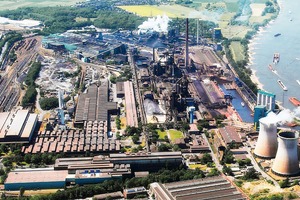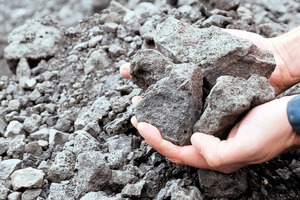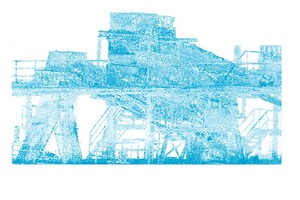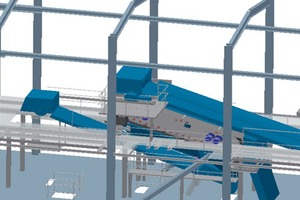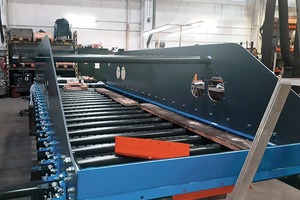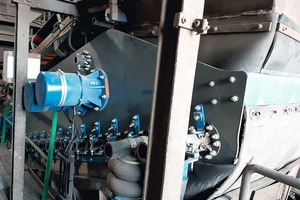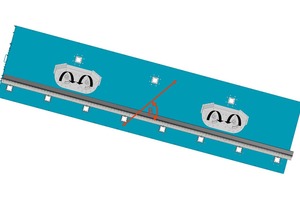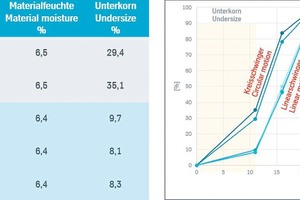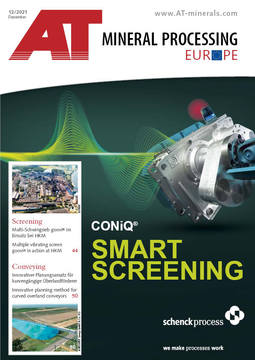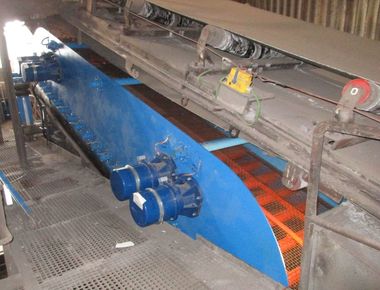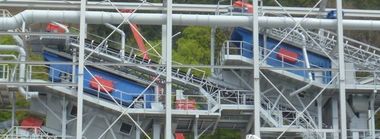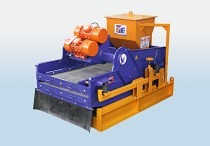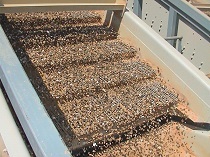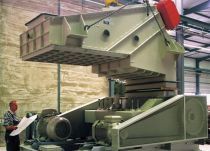Innovative multiple vibrating screen in action at HKM
goovi®, thyssenkrupp’s innovative multiple vibrating screen, not only promises to generate good vibrations, it also creates real added value for screen operators thanks to its significantly reduced weight and height as well as a substantial improvement in operational flexibility, product quality and capacity.
1 Introduction
After the development phase and initial test results from the
operation of a prototype, it was time to proof the goovi® in the field and verify the results from the test phase. The perfect opportunity for this came at Hüttenwerke Krupp Mannesmann GmbH (HKM) in Duisburg (Fig. 1), where the processing of different slags with widely varying properties places special demands on the screening equipment.
2 Features of the thyssenkrupp goovi®
The goovi® is designed for use in the secondary and tertiary screening stages, its key features being an innovative, patented drive system as well as many other, intelligent detail solutions.
It is driven by two or three standard unbalance motors at four different points, front and rear on each side of the screen, which are flange-mounted to the sidewalls (Fig. 2). This leads to significantly reduced stresses in the sidewalls and fewer rotating parts compared with conventional screens. As a result, weights and heights are lowered considerably, with reduced maintenance requirement and wear.
The goovi® control system is used for synchronization of the drive motors. With this, all screen vibrating modes (circular-, linear-, elliptical-motion) can be set with simple adjustments. Likewise, the speed and the direction of transport can be infinitely adjusted, so that all important operating parameters can be optimally adapted to production requirements at any time. Accordingly, it is possible to flexibly react to changing material properties (e.g. moisture content) and optimize the processing of difficult-to-screen materials during operation. Individual recipes, which can be activated as required, can be stored for different products. Thanks to full digitalization, the goovi® can also be integrated in control circuits and distributed control systems. A special cleaning function ensures the removal of pegged particles from the screen media and therefore high screening efficiency with reduced maintenance times.
3 goovi® replaces outdated circular motion vibrating screen
Hüttenwerke Krupp Mannesmann GmbH (HKM) (Fig. 3) specializes in the production of steel and intermediate products for the processing industry. With just under 3000 employees, the company produces around 4 mill. t steel annually. Besides technically and economically optimized production, HKM attaches particular importance to environmentally friendly and sustainable production. This also includes the full utilization of the mineral resources generated as by-products during steel production (Fig. 4). These are used largely as standardized products in road construction, earthworks, landfill and hydraulic engineering as well as in the cement industry.
3.1 Application
In the processing line for blast furnace and steel slag, HKM had been using a classical circular-motion vibrating screen that had to be replaced on account of its age. At the same time, the company wanted to optimize the process as performance and quality losses had regularly resulted, especially during the screening of wet material. Moreover, a particular challenge related to the installation was the limited space in the plant and the absence of an indoor crane.
A comparison of these specific requirements with the particular features of the goovi® from thyssenkrupp quickly showed that there is a high overlap and that a goovi® is optimally suited for the application.
The processing task is as follows: the two slags with a feed size of 0 – 45 mm have to be classified into three fractions: 0 – 11 mm, 11 – 22 mm und 22 – 45 mm. A particular quality requirement was an undersize percentage of < 10 % in the different fractions. This requirement could be met efficiently with the existing circular-motion vibrating screen in the summer with almost dry material. However, in wet weather, the slags that are stored outdoors have a high moisture content above 6 % and therefore a sticky consistency. This led to a considerably increased percentage of undersize in the different products, pegging of particles in the screen and frequent production downtime, a high maintenance requirement and much reduced throughput rate.
3.2 Planning
The first task in the planning of the project was to precisely analyse the installation situation on site as the goovi® was to be installed in the same position and with the same connection dimensions as the existing screen in the plant. As a result, efforts for changing the surrounding steel structure should be largely avoided. As a first step, the existing plant was laser-scanned (Fig. 5). From the acquired data, a precise drawing of the current installation situation was derived into which the new screen was planned (Fig. 6).
As significant importance was attached to the parameterization in the design, an individual model could be created quickly for this application, which perfectly utilizes the existing points of support and is closely based on the geometry of the old screen. In line with requirements, the screening area of 1.8 m x 6.0 m (10.8 m²) of the single-deck screen was divided into a section for the 0 – 11 mm product in the feed area and a section for the 11 – 22 mm product in the discharge area. At the screen overflow, the product 22 – 45 mm is recovered. Similar to the predecessor screen, the screening panels consist of wire mesh.
3.3 Installation
In the given circumstances, the new screen could not be installed according to any standard procedure. The assembly experts from thyssenkrupp and HKM therefore decided to have the screen delivered in parts and assemble it at its designated position in the plant. In this way, it was possible to avoid both the dismantling of other plant components and adjustments at the transfer points, which resulted in enormous cost and time savings.
To preclude any problems during assembly, the screen was put together prior to delivery at thyssenkrupp’s workshop in Ennigerloh (Fig. 7), checked and then dismantled again for transport.
This plan worked, and after just three days, the installation work was complete despite very difficult conditions (Fig. 8) and the test runs could commence. The lightweight and modular design of the goovi® proved a crucial advantage for assembly as the individual components of the screen had to be put in position with chain hoists as no crane was available in the plant.
3.4 Operation
The goovi® is operated primarily as a circular-motion vibrating screen at HKM, like the predecessor screen had been. Up to a moisture content of 4 – 5 % in the feed material, the screen can be operated in this way almost without any pegging of particles, and with less than 10 % undersize in the product, at a throughput rate of around 200 t/h. At higher moisture contents, the fine particles stick increasingly to the coarse particles. Consequently, the undersize percentage increases above the specified limit and the number of pegged particles also rises. Up to now, the only way to combat this was to drastically reduce the material feed rate. This reduces the bed height on the screening panel, as a result of which the sticking particles can be loosened better.
Being aware of this problem, various operating modes (recipes) were stored in the control system of the new goovi®, which have been adapted to the different material properties and can be called up as required. For this purpose, the screen only has to be stopped once for it to immediately resume operation in a different screening mode.
As individual particles are exposed to a higher impulse during linear screen motion, a reduced percentage of undersize can be expected with this mode of screen vibration. For this reason, for feed with a moisture content above 6 %, the screening mode of the goovi® is switched from circular to linear motion. This improves distribution of material on the screen considerably, and following several test cycles, it was established that a throw angle of the linear vector of 80 ° (Fig. 9) yields the best operating performance.
The undersize percentage could therefore, in contrast to circular-mode vibration, be kept under 10 % with fewer pegged particles (see Table 1). A slight increase of the speed from 850 rpm to 900 rpm resulted in further improvement. The crucial point here is that with these settings the goovi® can be operated at full capacity even with moist feed material, and accordingly delivers almost double the throughput of which was achieved with the old circular-motion vibrating screen.
4 Conclusion
The tests have clearly shown that, thanks to the possibility to adapt important operating parameters to the application, the goovi® offers high potential for optimization in respect of the required performance. This is of significant importance for screen operators, especially in the case of high requirements for certain product properties and the processing of difficult-to-screen materials. In future, it will therefore be easier to fulfil the sometimes strict requirements specified in standards for aggregates for the construction industry.
Moreover, the use of a goovi® enables the production of different products with one and the same machine. It can be used to influence product properties. Also, different feed materials from various deposits or with seasonally varying properties can be optimally processed, as the example described above clearly shows. Operation-related interruptions caused by blinding of the screening panel and maintenance work can be minimized.
Besides flexibility in production, another feature of the goovi® is its high adaptability to the spatial conditions at existing plants and easy assembly. Accordingly, the screen is optimally suited for replacing existing machines, eliminating the need for cost-intensive adjustments of other plant components.
Application at HKM has shown impressively that thanks to its revolutionary drive concept and many intelligent detail solutions, the goovi® from thyssenkrupp provides operators with a wide range of possibilities to improve the quality of their products and increase their production.
Authors:
Dr.-Ing. Armin Greune
thyssenkrupp Industrial Solutions AG, Beckum/Germany
Armin Greune studied mechanical engineering at TU Braunschweig and earned his PhD at the University of Hanover. From 1991 to 1997, he worked as head of the Process Engineering Department at Krupp Fördertechnik GmbH. From 1998 to 2014, he managed the Hazemag division at Hazemag & EPR GmbH. From 2014 to early 2021, he was responsible for the global Standard Machines Business of the Mineral Processing Division at thyssenkrupp Industrial Solutions AG and now supports this division as Senior Expert.
B. Eng. Peter Berlitz
thyssenkrupp Industrial Solutions AG, Beckum/Germany
Peter Berlitz studied mechanical engineering at Dortmund University of Applied Sciences. Since 2012, he has advanced through various stations at ThyssenKrupp Fördertechnik and subsequently at thyssenkrupp Industrial Solutions AG, from design through project management to the sale of mineral processing machinery. Today he is deputy manager for the product line “Screens & Feeders” and responsible for the goovi®.



